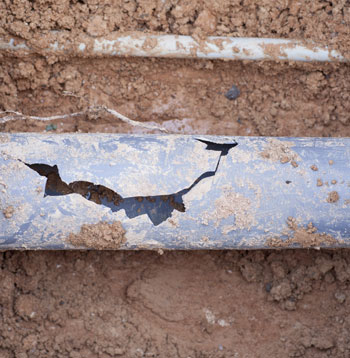
Comprehensive Sewer Repair
Professional Help for Sewer Problems
If you need sewer line repair services, you’re not alone. Sewer lines can experience extensive damage from burst pipes or freezing temperatures, which can lead to sewage backing up and ruining floors and carpets. In some cases, the damage is so severe that entire sections of the line need to be replaced.
One of the worst issues a property owner can encounter is a sewer problem. However, you shouldn’t try to tackle sewer problems on your own. Thus, when you suspect you have a sewer issue, it’s time to call a professional. Of course, it isn’t always easy to find the right company. Whether you suspect you may need a sewer repair or are looking for maintenance or inspection services, Wood’s Plumbing is your local resource. We’re here to provide the fast, professional, and accurate sewer services you require. In order to better serve our customers, we are located in Tucson, AZ.
What are the common causes of sewer line damage?
Sewer line damage can be caused by a variety of factors, including burst pipes, freezing temperatures, and heavy rains. In some cases, the damage is so severe that entire sections of the line need to be repaired or replaced.
Some of the common causes are:
- Poor maintenance and wear and tear of the sewer pipes
- Buildup of hair, debris, grease, sludge, oil, and toilet paper can cause clogs in the drains, damaging them.
- Infiltration of tree roots
- Freezing or thawing of the ground in winter
- Earthquakes, or any earth movement due to heavy construction etc.
- Improper layout or design of the sewer pipe/pipe lining
What are the signs of a broken sewer pipe?
It is important to be aware of the signs of a damaged sewer system in order to prevent further damage. If you suspect that your sewer system is damaged, it is important to contact an experienced service technician as soon as possible.
Signs of Sewer Line Damage
Flooded or Foul-Smelling Yard
If your yard is flooded, it could be a sign of a broken sewer pipe. Sewer lines can be buried anywhere between a couple of feet to six feet below the ground, with colder climates requiring deeper pipes. For sewer lines close to the surface, a broken pipe can quickly allow water to seep through the grass and become visible on the surface. You may be able to smell the sewage even before it surfaces, as sewage gas seeps through the soil in the yard.
Drainage Issues
If you have multiple drainage areas in your home that are clogged, it is likely that you have a blockage in your main sewage line. If you hear strange gurgling sounds coming from your toilet, it may be a warning sign of a severe blockage.
Water Damage
You will notice signs of water damage in your home in case of a leak or break in the drainage line. If you see mold spreading on the floors or walls, it is the first sign of water damage. These signs point towards a broken sewer line, so it is advisable to call a plumbing service immediately.
Sewer Ejection Products and Services
Ejector pump systems can have either one or two pumps.
Dual pump systems cycle between the two pumps, keeping one of them as a reserve pump in case the other stops functioning. As you might guess, single pump systems come with just one pump.
All pumps have either a check valve or one-way valve attached. This allows sewage to be pumped out of the holding tank. When the pump stops operating, however, the check valve does not allow the residue in the line to drain back into the tank. The best type of check valve is a ball valve.
If any of the floats or check valves in a system goes bad, then they can cause damage to—or even totally burn out—the pump. When you need professional sewer repair, keep us in mind. We have experience in the maintenance and repair of ejector pump systems, so we’re ready and able to serve your needs. If you have any questions, we’ll be happy to answer them for you!
Types of Ejector Pumps
- Grinder pumps – like a garbage disposal on steroids
- Standard pumps – no grinder capability
- Sump pumps – for pumping water only
Types of Ejector Pumps
Grinder Pumps
A grinder pump will grind up almost anything to a liquid, and then pump it out of the holding tank. Grinder pumps are more expensive than standard ejector pumps, but they are also a better option. They are also highly efficient.
Standard Pumps
A standard ejector pump does not have a grinder capability. Without the grinder action, just about anything can plug the impellers on the pump. These are less expensive than grinder pumps, but they also tend to have more problems and require more servicing.
Sump Pumps
A sump pump should not be confused with a sewer ejector pump. Sump pumps are for pumping water only, and—as everyone knows—not all sewage is liquid. This, of course, makes it a less popular option.
Sewer Inspections via Video Camera
We offer a thorough camera inspection of the sewers to determine the issues with the sewer system. Clogs can be a symptom of bigger problems with your pipes, so it’s important to diagnose what those issues might be. We have dependable electronic inspection equipment that allows us to see inside sewer piping, detect the problem and location, and come up with a plan to fix the problem.
FAQS:
Who provides the best sewer pipe repair services?
If you are located in or around Tucson and think you may require sewer repair, or are in need of maintenance or inspection services, Wood’s Plumbing is your best local option. We are proud to offer fast, professional, and accurate sewer services to our customers in Tucson, AZ. Our convenient location allows us to serve our customers better.
What is the pipe bursting method?
Pipe bursting is a method of breaking up an existing pipe so that a new one can be put in its place. A bursting tool is used to force the old pipe outward, making room for the new one. A hydraulic or pneumatic expansion head is pulled through the existing pipeline using a cable and winch. This process is known as bursting and is used to expand the pipeline so that it can accommodate a larger diameter pipe.
Sewer Leak Indicators
- Chronic backup of the sewer system
- Musty odors coming from either floors or walls near drains
- Mildew near drains
- Sewer odor
- Unusually moist or wet areas in the yard
- Exceptionally healthy plants (plants love nutrients found in sewage)




